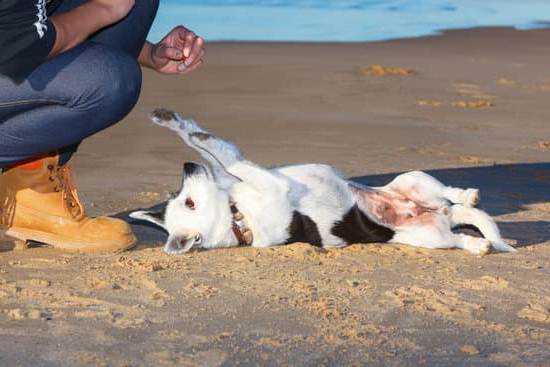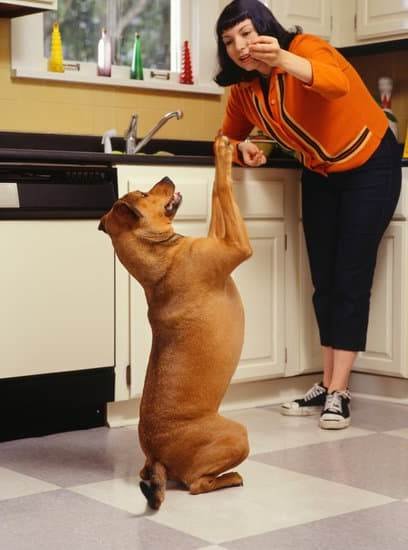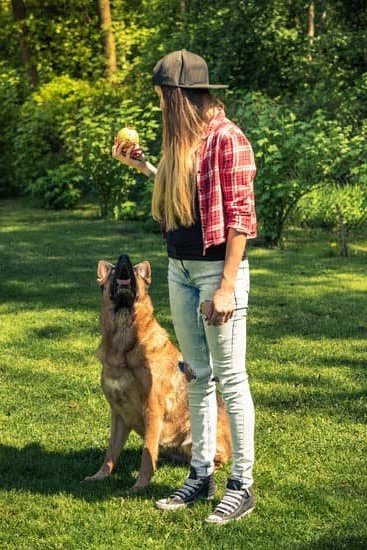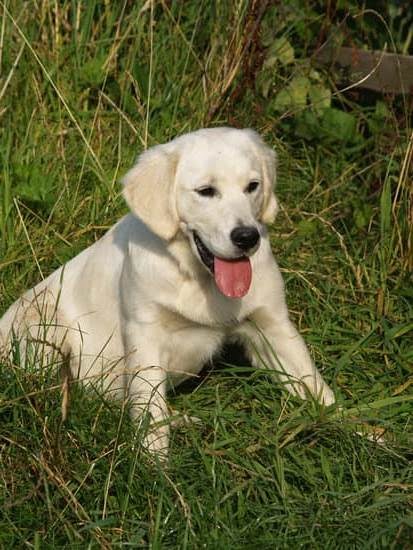How can I potty train if I can’t take my dog outside? This question may be a familiar one for dog owners who live in apartments, high-rise buildings, or in areas with extreme weather conditions. Indoor potty training presents its own set of challenges, but it is certainly achievable with the right approach and tools.
One of the main challenges of indoor potty training is creating a designated area indoors where your dog can relieve itself. In this article, we will explore some tips for establishing an indoor potty area that is both convenient for you and comfortable for your dog. We will also discuss the key supplies needed for successful indoor potty training, as well as how to train your dog to use indoor potty pads or grass patches.
Consistency and routine are vital components of any successful potty training method, whether indoors or outdoors. We will delve into the importance of maintaining a consistent schedule and using positive reinforcement techniques to encourage your dog to use the designated indoor potty area. Additionally, we will address common problems that may arise during indoor potty training and provide troubleshooting tips for overcoming these obstacles.
Tips for Creating a Designated Potty Area Indoors
Indoor potty training can be a challenge, especially if you’re unable to take your dog outside. Creating a designated potty area indoors is crucial for successful training. One of the first tips for creating a designated potty area indoors is to choose a spot that is easily accessible for your dog but also out of the way. This could be in a laundry room, bathroom, or even a corner of the kitchen.
Once you’ve chosen the location for the designated potty area, it’s important to cover the floor with potty pads or artificial grass patches. These materials will help contain any messes and make clean-up easier. If you opt for potty pads, make sure to secure them in place using adhesive strips or holders designed for this purpose.
In addition to having the right supplies, it’s essential to establish a routine for your dog’s indoor potty breaks. Take your dog to the designated area at regular intervals throughout the day, such as after meals, playtime, and naps.
Consistency is key when it comes to creating a designated indoor potty area, so be patient and persistent with your training efforts. By implementing these tips, you can effectively create a designated potty area inside your home and begin the process of indoor potty training even if you’re unable to take your dog outside consistently.
Key Supplies Needed for Indoor Potty Training
When it comes to indoor potty training for your dog, having the right supplies is crucial for success. Here are some key items you will need to effectively train your dog to use an indoor potty area:
- Indoor potty pads or grass patches: These are essential for providing a designated area for your dog to use the bathroom indoors. Potty pads are convenient and easy to clean up, while grass patches provide a more natural feel for your pup.
- Treats and positive reinforcement: Using treats as rewards for successful potty training is a great way to encourage good behavior. Positive reinforcement is key to reinforcing the desired bathroom habits in your dog.
- Cleaning supplies: Accidents are inevitable during the potty training process, so be sure to have enzymatic cleaners on hand to thoroughly clean up any messes. This will help eliminate odors and discourage repeat accidents in the same spot.
- A designated potty area: Whether it’s a specific room, corner, or area of your home, designating a consistent spot for your dog’s indoor bathroom needs will help reinforce good habits.
These supplies are essential for creating an effective indoor potty training routine for your dog. By utilizing these key items, you can set yourself and your furry friend up for success in learning how to effectively manage indoor bathroom habits.
As you gather the necessary supplies and prepare to embark on indoor potty training with your dog, you may be wondering, “How can I potty train if I can’t take my dog outside?” The good news is that with the right tools and techniques, it is entirely possible to successfully train your dog to use an indoor potty area.
With patience, consistency, and the proper supplies, you can overcome the challenges of not being able to take your dog outside for regular bathroom breaks.
Training Your Dog to Use Indoor Potty Pads or Grass Patches
Understanding the Benefits of Indoor Potty Training
Indoor potty training can be a life-saver for dog owners who are unable to take their pets outside for bathroom breaks. Whether it’s due to extreme weather conditions, physical limitations, or living in a high-rise apartment, indoor potty training provides a viable solution for ensuring that your dog can relieve themselves in a designated area within the comfort of your home.
Introducing Your Dog to Indoor Potty Options
When it comes to indoor potty training, there are two main options: potty pads and grass patches. Potty pads are convenient disposable pads that can be placed in an easily accessible area for your dog to use.
On the other hand, grass patches provide a more natural outdoor-like experience for dogs and can be a great alternative if you have limited outdoor access. Whichever option you choose, it’s important to introduce it to your dog in a positive and encouraging manner.
Training and Encouraging Your Dog
Once you’ve set up the designated indoor potty area with either potty pads or grass patches, it’s time to begin the training process. Start by actively encouraging your dog to use the designated spot, using positive reinforcement such as treats and praise when they do so successfully. Additionally, be patient and consistent with your training efforts, as some dogs may take longer than others to adjust to this new routine.
By following these tips and remaining patient and consistent with your efforts, you can successfully train your dog to use indoor potty pads or grass patches. Remember that every dog is different, so it’s essential to tailor your approach based on your pet’s specific needs and behaviors. With time and dedication, indoor potty training can become an effective solution for both you and your furry companion.
The Importance of Consistency and Routine in Indoor Potty Training
Indoor potty training for dogs comes with its own set of challenges, especially when you are unable to take your dog outside. One of the key factors in successfully potty training your dog indoors is consistency and routine. Without the option of outdoor walks, it’s essential to establish a strict routine for your dog’s potty breaks and to be consistent in your training approach.
Establishing a Potty Schedule
Creating a consistent schedule for your dog’s potty breaks is crucial. This means taking your dog to their designated indoor potty area at the same times every day, such as first thing in the morning, after meals, and before bedtime. By sticking to a strict schedule, you can help your dog understand when it’s time to go potty and reduce the likelihood of accidents.
Setting Clear Expectations
Consistency also involves setting clear expectations for your dog. Use verbal cues or commands to signal that it’s time for them to use their designated potty area. Consistently using the same cue will help your dog understand what is expected of them and improve their success rate in using the indoor potty spot.
Monitoring and Supervision
Being consistent also means keeping a close eye on your dog, especially during the initial stages of indoor potty training. By closely monitoring your dog’s behavior and supervising them during their scheduled potty breaks, you can quickly correct any mistakes and guide them towards using the designated spot.
By maintaining consistency and a strict routine in indoor potty training, even without the option of taking your dog outside, you can effectively teach them where they should go potty indoors. This strong foundation will set the stage for successful indoor potty training despite not being able to take your dog outside for traditional walks.
Managing Accidents and Cleaning Up Effectively
Accidents are an inevitable part of the potty training process, especially when we’re unable to take our dogs outside. However, with the right approach and preparation, managing accidents and cleaning up effectively can minimize stress and frustration for both you and your furry friend. Here are some tips on how to handle accidents and clean up effectively:
1. Be prepared: Stock up on cleaning supplies such as enzymatic cleaners, paper towels, disposable gloves, and odor eliminators. Having these items readily available will make cleaning up accidents less daunting.
2. Act quickly: When you discover an accident, it’s important to act fast. Blot the mess with paper towels to absorb as much liquid as possible, then use an enzymatic cleaner to remove any remaining odor or stain.
3. Establish a routine: Since accidents are more likely during times of transition or excitement, stick to a consistent schedule for potty breaks and meals. This will help reduce the likelihood of accidents occurring in the first place.
Remember that patience is key when managing accidents during indoor potty training. With a positive attitude and consistent effort, you can effectively clean up messes and continue making progress in your potty training journey.
Positive Reinforcement Techniques for Successful Indoor Potty Training
Positive reinforcement is a crucial aspect of successful indoor potty training for your dog, especially when you are unable to take them outside. By using positive reinforcement techniques, you can effectively encourage and reward your dog for using their designated indoor potty area.
One of the key ways to do this is by offering praise and treats whenever your dog successfully uses their indoor potty spot. This positive association will reinforce the desired behavior and encourage them to continue using the designated area.
In addition to praise and treats, another positive reinforcement technique for indoor potty training is to use a clicker. This tool can help mark the precise moment when your dog eliminates in the right spot, which allows you to immediately reward them with praise or a treat. With consistent use of the clicker, your dog will quickly learn that using the indoor potty area leads to positive results, further reinforcing this behavior.
Consistency is also essential when implementing positive reinforcement techniques for indoor potty training. By consistently rewarding your dog each time they use their designated indoor potty spot, they will begin to understand what is expected of them. Consistent positive reinforcement helps create a clear understanding for your dog of where they should eliminate, leading to successful indoor potty training.
Ultimately, by utilizing positive reinforcement techniques such as praise, treats, clicker training, and maintaining consistency, you can effectively encourage and support your dog in their indoor potty training efforts despite not being able to take them outside. These methods create a positive environment that motivates your dog to continue using their designated indoor potty area.
Troubleshooting Common Problems in Indoor Potty Training
When it comes to indoor potty training, dog owners may encounter various challenges that can hinder the process. One common problem that many face is the issue of their dog refusing to use the designated potty area indoors.
This can be frustrating and may make pet owners wonder, “How can I potty train if I can’t take my dog outside?” Fortunately, there are several strategies and techniques that can help address this issue and ultimately lead to successful indoor potty training.
One of the key tips for troubleshooting this problem is to carefully observe your dog’s behavior and preferences. Some dogs may have a natural aversion to using a designated potty area indoors, especially if they have been accustomed to going outside. In such cases, it is important to make the indoor potty area as appealing as possible by choosing a spot that offers privacy and minimizing distractions.
Additionally, it may be helpful to consider the type of surface or material used in the designated indoor potty area. Some dogs may prefer grass patches, while others may be more inclined to use specific types of potty pads. By experimenting with different options and observing your dog’s response, you can determine the most suitable choice for your furry friend.
Consistency is also crucial when troubleshooting problems in indoor potty training. By establishing a routine and providing positive reinforcement whenever your dog uses the indoor potty area, you can gradually encourage them to adopt this new behavior. With patience and perseverance, even the most reluctant dogs can eventually learn to use an indoor bathroom solution effectively.
Transitioning From Indoor to Outdoor Potty Training When Possible
Transitioning your dog from indoor potty training to outdoor potty training can be a significant milestone, especially if your initial training was due to limitations that prevented you from taking your dog outside. Once these limitations are resolved, such as the completion of vaccinations or the end of extreme weather conditions, you may start the transition process.
Begin by slowly introducing your dog to the outdoor environment. Start with short walks in a familiar and safe area, allowing your dog to become comfortable with being outside. Be patient and provide positive reinforcement for any signs of using the bathroom outside. Gradually increase the duration and distance of the walks, always observing your dog for any signs that they need to relieve themselves.
It’s important to maintain consistency in your routine even during this transition phase. If you were using a designated potty area indoors, try to replicate this setup outdoors initially. This can help your dog understand that they should still go in a specific spot, even if it’s now located outdoors. Additionally, continue using verbal cues or commands that you used during indoor potty training to help signal to your dog when it’s time to go.
| Key Supplies Needed | Description |
|---|---|
| Potty pads or grass patches | For transitioning from indoor potty training setups. |
| Treats and rewards | To reinforce positive behavior during outdoor training. |
| Clean-up supplies | For handling accidents during outdoor training. |
Conclusion
In conclusion, indoor potty training can be challenging, especially if you are unable to take your dog outside for bathroom breaks. However, with the right approach and consistency, it is possible to successfully train your dog to use a designated potty area indoors. By understanding the challenges and following the tips provided, you can create a routine that works for both you and your furry friend.
Remember that key supplies such as potty pads or grass patches are essential for indoor potty training. Additionally, positive reinforcement techniques and effective clean-up methods play crucial roles in the training process. It’s important to remain patient and consistent throughout the training period, as achieving success in indoor potty training will take time and dedication.
As you navigate through indoor potty training and manage accidents along the way, don’t forget to celebrate your successes no matter how small they may seem. Each step forward is a victory worth acknowledging.
And when the time comes that you are able to transition to outdoor potty training, you can look back on your journey with pride and know that you overcame the limitations of not being able to take your dog outside during the initial stages of training. With dedication and perseverance, indoor potty training is achievable, even under challenging circumstances.
Frequently Asked Questions
How Do You Potty Train a Dog That Can’t Go Outside Yet?
Potty training a dog that can’t go outside yet involves creating a designated indoor area for them to relieve themselves, such as a puppy pad or fake grass tray. Consistency, positive reinforcement, and patience are key.
What to Do if I Can’t Take My Dog Out to Potty?
If you can’t take your dog out to potty, consider using pee pads or artificial turf indoors. Ensure the area is easily accessible and clean up accidents promptly to maintain good hygiene.
What to Do if You Can’t Let Your Dog Out?
If you can’t let your dog out, provide them with alternative ways to exercise and relieve themselves indoors. This may include interactive toys, puzzle feeders, and scheduled playtime to keep them mentally and physically stimulated.

Welcome to the blog! I am a professional dog trainer and have been working with dogs for many years. In this blog, I will be discussing various topics related to dog training, including tips, tricks, and advice. I hope you find this information helpful and informative. Thanks for reading!





